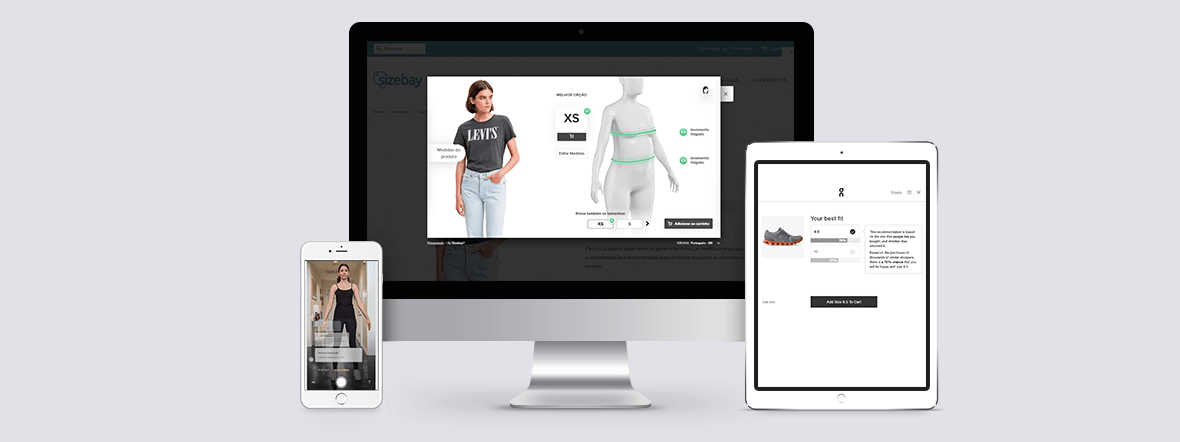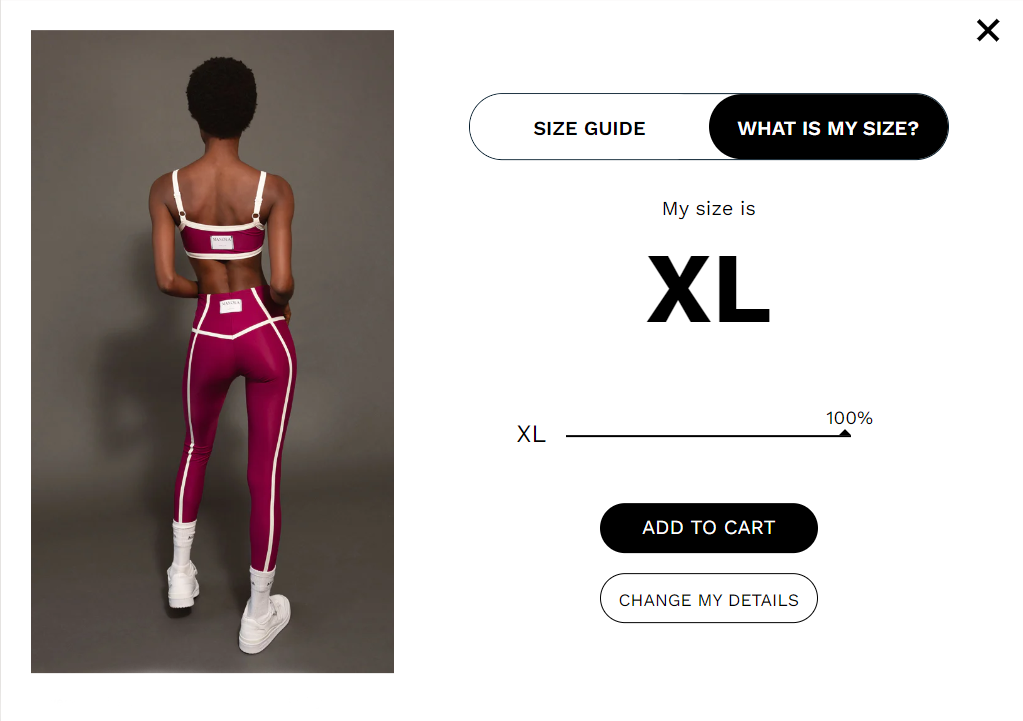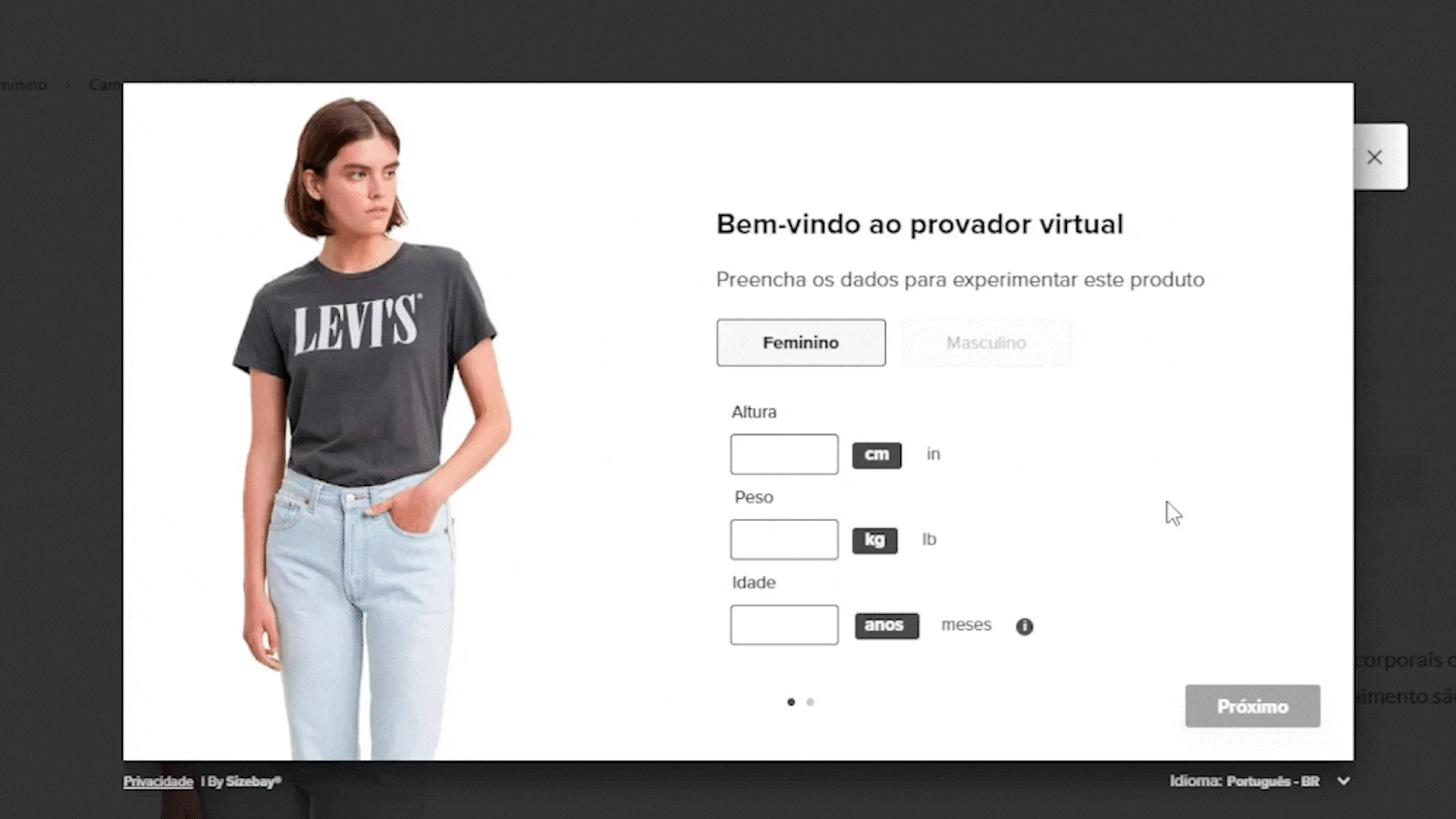Straight to the point
Everything you need to know about the technologies available for size recommendation in fashion e-commerce.
Shopping online has become the norm for many consumers, and the fashion industry is one of the fastest growing industries when it comes to sales. That growth is creating greater competition between brands, but also demanding innovations from e-commerce managers to adapt to the needs of the public and the market.
This increase in online shopping, coupled with new opportunities, has attracted the attention of companies looking to profile by proposing different retail solutions.
These solutions range from new payment methods, fraud prevention systems, to size recommendation algorithms, virtual assistants, and virtual fitting rooms.
In this article we’ll give you an overview of virtual fitting rooms, size charts, and size recommendation solutions in the online fashion retail space. We’ll explain how these solutions impact e-commerce businesses and the problems they try to address.

VIRTUAL FITTING ROOMS
Virtual fitting rooms attempt to provide users with an online shopping experience that is as close to trying on clothes in a physical fitting room as possible.
Virtual fitting rooms are innovative digital tools that enable online shoppers to visualize how clothing items would look on them without physically trying them on.
Using augmented reality or computer-generated imagery, virtual fitting rooms allow users to upload a photo or use their device’s camera to superimpose the selected clothing onto their body.
The technology provides a lifelike representation of how the apparel fits, drapes, and complements their body shape, helping customers make more informed purchasing decisions and enhancing their online shopping experience.
SIZE CHARTS
Size charts list the size categories of apparel and the corresponding body or garment measurements.
With the exception of size recommendation tools, they’re the main tool used by brands to help consumers pick the right size.
While many brands display garment measurements in their size charts, ideally they should display body measurement, as it can be difficult for users to choose the right size based on garment measurements.
PROS OF SIZE CHARTS
Size charts are already standard in online fashion stores and with the right communication can be easily understood by consumers everywhere. They’re also very cheap and easy to implement.
CONS OF SIZE CHARTS
The biggest problem with size charts, from the perspective of consumers, is that they require measuring. Regardless of whether a size chart uses garment or body measurements, consumers will still need a measuring tape and need to know how to take proper measurements. Even with a size chart available, many consumers will still struggle to pick the right size.
If you’d like to learn more, make sure to read about creating size charts for e-commerce businesses.

SIZE RECOMMENDATION TOOLS
Size recommendation tools use size chart data together with user-inputted data, such as body measurements, to recommend shoppers the best size of a garment. To be effective, they should be easily accessible and provide users with an experience closer to that of a physical store.
Most size recommendation technology uses AI algorithms, and can be broken down into two groups: statistical recommendations systems and anthropometric recommendation systems.
STATISTICAL SIZE RECOMMENDATION
Statistical size recommendation tools use past data to make size recommendations. These tools use user-inputted data along with data from past purchases and return rates to make size recommendations.
The algorithm will compare the user’s inputted body measurements with purchase data from past users with similar measurements. The tool then make a recommendation by crossing data on the most purchased size for that cohort and return rates.
For example, a 28 year old user who’s 6’2 and weighs 180 pounds, might have an 80% of being satisfied with a size large. This recommendation is given because 80% of past users with similar body measurements bought a size large and did not return their purchase.
PROS OF STATISTICAL RECOMMENDATIONS
Common solutions in the market estimate body measurements using weight, height, and age, and give users the option to fine-tune their body measurements. This approach establishes a reliable pattern, building consumer trust and addressing e-commerce challenges.
CONS OF STATISTICAL RECOMMENDATIONS
The biggest drawback of statistical recommendations is that they don’t take into account users’ individual style preferences. Some people prefer looser or tighter fitting clothing and these nuances aren’t captured by statistical recommendations.
In the example above, the user was told they have an 80% of being satisfied with a size large, but the user doesn’t know anything about the fit preferences of past shoppers. In other words, a size large might fit them but might not be the right size for their personal style.
Another aspect to consider is accuracy, since there’s still a chance the model will recommend the wrong size.

ANTHROPOMETRIC SIZE RECOMMENDATION
Anthropometric models collect the same body data as statistical models, like weight, height, and age. The difference is that they can estimate up to 7 body measurements with great precision.
The model will then compare those body measurements with size charts provided by the retailer to make specific size suggestions based on the user’s body measurements.
PROS OF ANTHROPOMETRIC SIZE RECOMMENDATION
Since anthropometric recommendations take into account real body data and each product’s size chart, recommendations are personalized for each user’s body.
Another benefit is that users can see how each size will fit them. For example, a user might receive the recommendation that a large will fit them, a medium will be a little short, and an extra large will be loose. This added level of personalization lets shoppers make more confident decisions by taking into account their personal preferences.
Curious about the results of this approach? Click here to read how Sizebay helped Lanidor, a Portuguese fashion brand.

CONS OF ANTHROPOMETRIC SIZE RECOMMENDATION
Anthropometric size recommendation tools require more maintenance than statistical models. Since they use users’ body measurements together with product size charts, online fashion retailers need to keep their size charts up-to-date with whatever recommendation platform they’re using.
Even though maintenance is low, if brands don’t keep their size charts updated, the tool will not be able to provide accurate size recommendations..
WHAT IS THE PURPOSE OF SIZE RECOMMENDATION TOOLS?
Now that you understand the difference between the most common solutions, let’s examine why they’re so important and how they play a big role in helping fashion ecommerce businesses.
Size recommendations tools have a huge impact on return rates and conversion rates.
Product exchanges and returns in North American e-commerce, stimulated by free exchange policies, have reached impressive numbers. In 2021, retailers across the board had to absorb an estimated $761 billion worth of products returned to stores, which represents a 16.6% increase from the previous year.
In the context of fashion e-commerce, size recommendations play a major role in decreasing exchanges and returns. Data from Power Reviews from 2021 showed that one of the top reasons for fashion product returns in the US was product size and fit issues (70%), followed by products received with damage or defects (65%).
By helping shoppers pick out the right size, size recommendation tools help greatly reduce returns due to incorrect sizing. And since many shoppers give up on purchases because they’re unsure what size to purchase, conversion rates are also impacted by size recommendation tools.
WHAT ARE THE BENEFITS OF SIZE RECOMMENDATION TOOLS?
By helping customers pick out the right size, size recommendation tools confer a number of benefits for online fashion retailers, these include:
- A more personalized experience;
- Increased sales conversions;
- Reduced expenses related to exchanges and returns;
- Increased customer loyalty
While any size recommendation tool you implement can provide these benefits, some are more effective than others.
PICKING THE RIGHT TOOL FOR YOUR ONLINE STORE
If your e-commerce business is implementing conversion rate optimization strategies, offering a size chart alone may not be enough. In this case, the best tools to implement are anthropometric size recommendation tools and virtual fitting rooms.
Anthropometric size recommendation tools are the best option if your online store is suffering from excessive exchanges and returns, since customers can customize their recommendations.
For example, Canadian fashion brand Miik, chose Sizebay because they wanted to provide personalized recommendations and not just recommend customers a single size. They believe that individual body measurements make much more sense for their audience and the recommendations provided.
Another reason they decided to implement a size recommendation tool were customer service related issues. Even if an online store has a good customer support team, if answering customer sizing questions takes too long to answer, businesses can lose sales to the competition that may answer those questions faster.
We recorded a success case with Miik, which you can watch below::
If you want to provide a better shopping experience for your customers and help them make confident decisions, you need to invest in some kind of size recommendation software.
We hope this article has helped you understand the main size recommendation tools on the market and how they adapt to customer needs.

